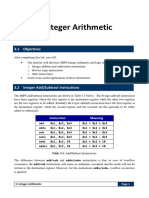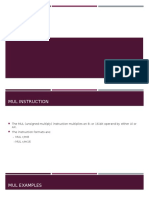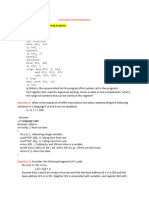Computer Architecture Lab 06
Uploaded by
Itz Sami UddinComputer Architecture Lab 06
Uploaded by
Itz Sami UddinInteger Multiplication
6 and Division
6.1 Objectives
After completing this lab, you will:
• Understand binary multiplication and division
• Understand the MIPS multiply and divide instructions
• Write MIPS programs that use integer multiplication and division
6.2 Binary Multiplication
Sequential binary multiplication is a simple but slow form of multiplication. It is performed using
addition and shift operations as illustrated in Figure 6.1. The multiplication of two 32-bit integers is a
64-bit product stored in two registers: HI and LO.
Figure 6.1: Sequential Binary Multiplication Algorithm
Register HI is initialized with the value 0, and LO is loaded with the value of the multiplier. The
sequential algorithm is repeated 32 times for each bit of the multiplier. Finally, the product is
computed in two registers HI and LO.
6: Integer Multiplication and Division Page 1
Figure 6.2 shows a simple sequential binary multiplier for unsigned integers. It uses a 32-bit ALU, a
register for storing the multiplicand, a shift register (HI and LO) for storing the final product, and
simple control. Instead of shifting the multiplicand to the left, the product is shifted to the right. It has
the same net effect and computes the same result. The control examines each bit of the multiplier
LO[0]. If a bit of the multiplier is 1, then an addition is done: HI = HI + Multiplicand. Then the HI
and LO registers are shifted to the right and the carry bit is inserted. This is repeats 32 times to
compute the 64-bit product in HI and LO.
Figure 6.2: Sequential Binary Multiplier
Signed multiplication can also be performed using the same sequential binary multiplier, but with
minor modification. When adding (HI + Multiplicand) the proper sign bit of the result is computed,
instead of the carry bit. When shifting the HI and LO registers to the right, the sign-bit is inserted to
the left of the product. Additions are used for the first 31 steps. However, the last step should use
subtraction (rather than addition), if the sign-bit of the multiplier is negative.
Sequential binary multiplication is slow because it requires one cycle for each bit of the multiplier.
Faster binary multiplication can be done in hardware, as shown in Figure 6.3. The cost of the binary
multiplier increases because it uses many adders, instead of just one used as in Figure 6.2.
Figure 6.3: Faster Integer Multiplier
6: Integer Multiplication and Division Page 2
6.3 Binary Division
Sequential binary division can be performed using shift and subtract operations. Binary division
produces a quotient and a remainder. It also uses two registers HI and LO. The quotient is computed
in the LO register and the remainder is computed in the HI register. HI is initialized with zero and
LO is initialized with the dividend. At each iteration step, registers HI and LO are shifted left by 1
bit. The difference: (HI – Divisor) is computed. If this difference is ≥ 0, the Remainder (HI register)
is set equal to the difference and the least significant bit of the quotient (LO register) is set to 1. The
sequential binary division algorithm is repeated 32 times, as shown in Figure 6.4.
Figure 6.4: Binary Division Algorithm
A simple but slow sequential binary divider is shown in Figure 5.5. It uses a 32-bit ALU that does
subtraction. It also uses HI and LO registers, a Divisor register, and simple control logic to shift left
the HI and LO registers and set the least-significant bit of LO. The control logic repeats 32 times to
compute each bit of the quotient in LO. The final remainder will be in the HI register.
Figure 6.5: Sequential Binary Divider
6: Integer Multiplication and Division Page 3
6.4 MIPS Integer Multiply and Divide Instructions
Multiplication and division generate results that are larger than 32 bits. Multiplication produces a
64-bit product while division produces a 32-bit quotient and a 32-bit remainder. The MIPS
architecture provides two special 32-bit registers that are the target for integer multiply and divide
instructions. The source operands come from the general-purpose register file. However, the results
are written into HI and LO registers. For multiplication, the HI and LO registers form a 64-bit
product. For division, HI stores the 32-bit remainder, while LO stores the 32-bit quotient.
MIPS defines two multiply instructions: mult for signed multiplication and multu for unsigned
multiplication. Both multiply instructions produce a 64-bit product without overflow. There is also
a third mul instruction that computes the same 64-bit product as a mult instruction in HI and LO
registers. However, the mul instruction also copies the LO register into destination register Rd. The
mul instruction is useful when the product is small and can fit in a 32-bit destination register.
Instruction Meaning Note
mult Rs, Rt [HI, LO] = Rs × Rt Signed multiplication
multu Rs, Rt [HI, LO] = Rs × Rt Unsigned multiplication
mul Rd, Rs, Rt [HI, LO] = Rs × Rt; Rd = LO Rd = Lower 32-bit of the product
Table 6.1: MIPS Integer Multiply Instructions
In addition, MIPS defines two integer divide instructions: div for signed division and divu for
unsigned division. The quotient of the integer division is saved in the LO register, while the
remainder is saved in the HI register as shown in Table 6.2.
Instruction Meaning Note
div Rs, Rt LO = Rs / Rt, HI = Rs % Rt Signed division
divu Rs, Rt LO = Rs / Rt, HI = Rs % Rt Unsigned division
Table 6.2: MIPS Integer Divide Instructions
If the divisor in register Rt is zero, then the MIPS divide instructions do not compute any result in
the HI and LO registers. Division by zero is ignored and no exception is produced. The MIPS
programmer must ensure that the divisor is non-zero when using the integer divide instruction.
Special instructions are used to move data between the HI and LO registers and general-purpose
registers. These are listed in Table 6.3.
6: Integer Multiplication and Division Page 4
Instruction Meaning Instruction Meaning
mfhi Rd Rd = HI mthi Rs HI = Rs
mflo Rd Rd = LO mtlo Rs LO = Rs
Table 6.3: Move Instructions for the HI and LO registers
6.5 Applications of Integer Multiply and Divide Instructions
Raising an integer number x to a power n (xn), may be computed using successive multiplications.
The following code uses integer multiplication to implement the power function. Registers $a0 and
$a1 are used to store x and n, while $v0 contains the result.
li $a0, 7 # number x
li $a1, 5 # number n
li $v0, 1 # $v0 = 1
pow:
mul $v0, $v0, $a0 # $v0 = $v0, $a0
addiu $a1, $a1, -1 # decrement n
bnez $a1, pow # loop if (n != 0)
The greatest common divisor can be computed as follows:
gcd(a, 0) = a
gcd(a, b) = gcd(b, a % b) where % is the remainder operator
For example,
gcd(30, 18) = gcd(18, 30%18) =
gcd(18, 12) = gcd(12, 18%12) =
gcd(12, 6) = gcd(6, 12%6) = gcd(6, 0) = 6
The following MIPS loop computes the gcd of two numbers stored in registers $a0 and $a1. The
final result is computed in register $a0.
li $a0, 30 # number a
li $a1, 18 # number b
gcd:
div $a0, $a1 # HI = remainder, LO = quotient
move $a0, $a1 # $a0 = number b
mfhi $a1 # $a1 = a % b (remainder)
bnez $a1, gcd # loop if (b != 0)
6: Integer Multiplication and Division Page 5
A string is an array of bytes stored in memory. For example, str is defined as a string of digits in
the data segment. The .asciiz directive is used to define an ASCII string stored in memory and
terminated with a NULL byte.
.data
str: .asciiz "512943687"
The string of digits can be read from memory and converted into a number. The lb (load byte)
instruction can read each character of a string from memory into a register. The following MIPS
loop converts the above string str into an integer computed in register $v0:
.text
main:
la $t0, str # load address of str into $t0
li $v0, 0 # Initialize $v0 = 0
li $v1, 10 # Initialize $v1 = 10
lb $t1, ($t0) # load byte: $t1 = Memory($t0)
str2int:
addiu $t1, $t1, -48 # convert character to a number
mul $v0, $v0, $v1 # $v0 = $v0 * 10
addu $v0, $v0, $t1 # $v0 = $v0 + digit
addiu $t0, $t0, 1 # point to next character in memory
lb $t1, ($t0) # load byte: $t1 = Memory($t0)
bnez $t1, str2int # loop back if not NULL character
done:
. . . # $v0 = integer result
An unsigned integer can be converted to a string by successive divisions by 10. The remainder is a
digit between 0 and 9. The remainder digits are computed backwards starting at the least significant
digit. Each remainder is then converted to an ASCII character and stored in memory in a string. For
example, consider converting the integer 5218 into a string. This can be done as follows:
5128 / 10 = 512, 5128 % 10 = 8 Convert 8 into character '8'
512 / 10 = 51, 512 % 10 = 2 Convert 2 into character '2'
51 / 10 = 5, 51 % 10 = 1 Convert 1 into character '1'
5 / 10 = 0, 5 % 10 = 5 Convert 5 into character '0'
Stop when the quotient is zero
The following MIPS code converts an unsigned integer stored in register $a0 into a string stored in
the data segment in memory. The string is initialized with 10 space characters. The string has 10
characters only because a 32-bit unsigned integer can have at most 10 digits.
6: Integer Multiplication and Division Page 6
.data
str: .asciiz " " # str = 10 space characters
.text
main:
li $a0, 5128 # $a0 = unsigned integer to convert
la $v0, str # load address of str into $v0
addiu $v0, $v0, 11 # $v0 = pointer at end of str
li $a1, 10 # Initialize $a1 = 10
int2str:
divu $a0, $a1 # divide $a0 by 10
mflo $a0 # $a0 = quotient
mfhi $t0 # $t0 = remainder (0 to 9)
addiu $t0, $t0, 48 # convert digit into a character
addiu $v0, $v0, -1 # point to previous space character
sb $t0, ($v0) # store byte: Memory($v0) = $t0
bnez $a0, int2str # loop back if quotient is not zero
done:
. . . # $v0 = pointer to string in memory
6.6 In-Lab Tasks
1. Write MIPS code to perform the following integer multiplications. What is the value of the LO
and HI registers?
a) 98765 × 54321 using the multu instruction
b) -98765 × -54321 using the mult instruction
2. Write MIPS code to perform the following integer divisions. What is the value of the LO and HI
registers?
a) 98765 / 54321 using the divu instruction
b) -98765 / -54321 using the div instruction
3. Factorial Calculation: Using the mul instruction, write a MIPS program that computes the
factorial of a number n input by the user, and display the result on the screen. Run your code
and record the maximum 32-bit factorial value that can be computed without errors.
4. The string-to-integer program presented in Section 6.5 converts a string of decimal digits to an
unsigned integer using successive multiplications by 10 and additions. It is also possible to
convert a string of digits in any radix system to an integer, using successive multiplications by
the radix value and additions. Rewrite the string-to-integer program asking the user to input a
6: Integer Multiplication and Division Page 7
radix value between 2 and 10 and a string of digits in the specified radix system. For example,
if the radix value is 8 then the string can only have octal digit characters from '0' to '7'.
Convert the string of digit characters into an unsigned integer and display the value of the
unsigned integer.
5. The integer-to-string program presented in Section 6.5 converts an unsigned integer to string
format using successive division by 10 and storing the remainder digit characters in a string. It
is also possible to convert the unsigned integer to any radix using successive divisions by the
radix value. Rewrite the integer-to-string program asking the user to input an unsigned integer
and a radix value between 2 and 10. Do the radix conversion and then print the string. Make
sure that the string has sufficient space characters, especially when converting to radix 2.
6. Fraction computation: Using successive integer multiplications and divisions, write a MIPS
program that divides an integer x by another integer y that are read as input. The result of the
division should be in the form: a.b, where a is the integer part and b is the fractional part.
Compute the fraction b with 8 digits after the decimal point. Display the result in the form a.b.
6: Integer Multiplication and Division Page 8
You might also like
- Foundations of Calligraphy by Sheila Waters10% (31)Foundations of Calligraphy by Sheila Waters6 pages
- Multiplication and Division InstructionsNo ratings yetMultiplication and Division Instructions31 pages
- Ethnographic Research and The Problem Data Reduction1: Judith Preissle Goetz and Margaret LecornpteNo ratings yetEthnographic Research and The Problem Data Reduction1: Judith Preissle Goetz and Margaret Lecornpte20 pages
- Computer Architecture - Lab 5: Integer Multiplication, Division and Arithmetic Shift InstructionsNo ratings yetComputer Architecture - Lab 5: Integer Multiplication, Division and Arithmetic Shift Instructions5 pages
- W12 - CT173 - Integer Multiplication and DivisionNo ratings yetW12 - CT173 - Integer Multiplication and Division30 pages
- Lecture 05 - Integer Multiplication and DivisionNo ratings yetLecture 05 - Integer Multiplication and Division7 pages
- Computer Arithmetic: Electrical and Computer Engineering DepartmentNo ratings yetComputer Arithmetic: Electrical and Computer Engineering Department72 pages
- Computer Arithmetic: Electrical and Computer Engineering DepartmentNo ratings yetComputer Arithmetic: Electrical and Computer Engineering Department72 pages
- MNM Lab # 3 Use of Multiplication and Division InstructionsNo ratings yetMNM Lab # 3 Use of Multiplication and Division Instructions5 pages
- TASK 1 - Integer Multiplication in The MIPS Assembly LanguageNo ratings yetTASK 1 - Integer Multiplication in The MIPS Assembly Language6 pages
- Exp-No6 Multiplication of 8 Bit and 16-Bit Numbers0% (1)Exp-No6 Multiplication of 8 Bit and 16-Bit Numbers2 pages
- Chapter 7 Arithmetic and Logical InstructionsNo ratings yetChapter 7 Arithmetic and Logical Instructions30 pages
- Bit Twiddling Hacks: by Sean Eron Anderson Seander@cs - Stanford.eduNo ratings yetBit Twiddling Hacks: by Sean Eron Anderson Seander@cs - Stanford.edu34 pages
- API Mnemonic Operands Function Controllers: Es/Ex/Ss Sa/Sx/Sc Eh/SvNo ratings yetAPI Mnemonic Operands Function Controllers: Es/Ex/Ss Sa/Sx/Sc Eh/Sv1 page
- MIPS Instruction Set: Arithmetic InstructionsNo ratings yetMIPS Instruction Set: Arithmetic Instructions6 pages
- Lecture 8: Binary Multiplication & DivisionNo ratings yetLecture 8: Binary Multiplication & Division20 pages
- MIPS Mul Div, and MIPS Floating Point InstructionsNo ratings yetMIPS Mul Div, and MIPS Floating Point Instructions13 pages
- Computer Organization & Assembly Language: MUL & DIV InstructionsNo ratings yetComputer Organization & Assembly Language: MUL & DIV Instructions19 pages
- Lecture 4 - GPIO and ISA i-type EECS 388No ratings yetLecture 4 - GPIO and ISA i-type EECS 38833 pages
- Cisc Vs Risc: Multiplying Two Numbers in MemoryNo ratings yetCisc Vs Risc: Multiplying Two Numbers in Memory4 pages
- COE301 Lab 14 Pipelined CPU Design With Stall CapabilityNo ratings yetCOE301 Lab 14 Pipelined CPU Design With Stall Capability4 pages
- COE301 Lab 13 Pipelined CPU Design With Data ForwardingNo ratings yetCOE301 Lab 13 Pipelined CPU Design With Data Forwarding8 pages
- 2023 - Sensory Nerve Sprouting Into Human Skin Explants ConfersImproved Survival To Merkel Cells Independent of Merkel Cell-Neurite ComplexesNo ratings yet2023 - Sensory Nerve Sprouting Into Human Skin Explants ConfersImproved Survival To Merkel Cells Independent of Merkel Cell-Neurite Complexes8 pages
- Economics The Basics 3rd Edition Michael Mandel download100% (4)Economics The Basics 3rd Edition Michael Mandel download24 pages
- Practice Sheet - Forest Society and Colonlism - SPRINT-OnE SHORT - Dimple Mam - Rohit PDFNo ratings yetPractice Sheet - Forest Society and Colonlism - SPRINT-OnE SHORT - Dimple Mam - Rohit PDF4 pages
- Python - 1. Introduction To The Python LanguageNo ratings yetPython - 1. Introduction To The Python Language3 pages
- Action Plan For School Paper Management and Campus Journalsim S.Y. 2020-2021No ratings yetAction Plan For School Paper Management and Campus Journalsim S.Y. 2020-20212 pages
- Bricks Made of Rubber Latex and Fly AshNo ratings yetBricks Made of Rubber Latex and Fly Ash52 pages
- Exergoeconomic Analysis of A 30 KW Micro Turbine Cogeneration System Using Hysys and MatlabNo ratings yetExergoeconomic Analysis of A 30 KW Micro Turbine Cogeneration System Using Hysys and Matlab6 pages
- VW SS22 DigitalPresentation SustainabilityNotesNo ratings yetVW SS22 DigitalPresentation SustainabilityNotes28 pages
- "Women's Grooming": So On. Humans Are Not The Only Species ThatNo ratings yet"Women's Grooming": So On. Humans Are Not The Only Species That22 pages


































































































